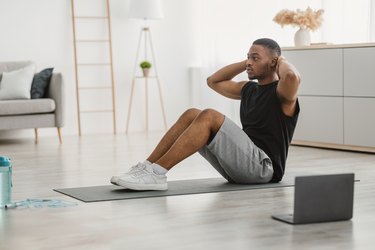
A strong core is essential not just for athletic performance, but for daily life, too. Any time you walk, run, stand, bend over, reach for something or lift something up, your core is involved. So, it's important to regularly incorporate exercises into your workout routine that strengthen these muscles.
The best core exercises involve core stabilization, and as you progress in your fitness journey, you can't go wrong with the classic sit-up. They're pretty straightforward to do and require no equipment, making them accessible. However, they're also easy to make harder if you're looking for a bit of a challenge — just add weights or try one of these variations.
Video of the Day
While it may seem like doing a sit-up is easy, it's often hard for beginners to do because they don't yet have the strength to control their body movements up and down. It's best for a beginner to learn how to stabilize their core first with exercises like the dead bug or bird dog before moving on to a dynamic movement like the sit-up.
The sit-up actually isn't a great beginner core exercise because a lot of beginners can not control their body movement correctly going up and down. It's best for a beginner to learn how to stabilize their core first then move to a dynamic movement, like a sit up.
If you want to know exactly what muscles do sit-ups work, we've got you covered. Some may even surprise you.
The Muscles Sit-Ups Work
1. Rectus Abdominis
The rectus abdominis is the primary muscles worked in sit-ups. This is your "six-pack" muscle that stretches down the middle of your abdomen, going from your ribs to the front of your pelvis, according to the Cleveland Clinic. The rectus abdominis "holds your internal organs in place and keeps your body stable during movement," per the Cleveland Clinic.
2. Internal and External Obliques
Your external obliques also attach to the rib cage and the pelvis, but to either side of the rectus abdominis, per the Cleveland Clinic. They're the primary muscles for twisting your body back and forth and for tilting your rib cage from side to side. When contracted simultaneously, however, they aid the rectus abdominis in crunching the rib cage directly toward the pelvis, which occurs during a sit-up.
Your internal obliques sit on top of your external obliques, according to the Cleveland Clinic, and work in tandem with your external obliques when you twist your torso.
3. Iliopsoas
Your hip flexors, also known as the illiopsoas, assist you when you flex and extend your torso, as happens when you rise and lower during a sit-up, according to the University of New Mexico.The hip flexors are a group of muscles that connect the femur, or thigh bone, to the pelvis. They're also activated when you sit, stand, run, walk or squat.
4. Rectus Femoris
Although you think of sit-ups as an abs-specific move, you may feel the fronts of your thighs fatigue after you've performed a number of reps.
This is because the muscles of your quadriceps, including the sartorius and rectus femoris, are engaged as you do a sit-up, per the University of New Mexico. The primary function of your quad muscles is to straighten your leg at the knee and flex your thigh at the hip joint.
5. Accessory Muscles
Depending on your technique, additional muscles are worked during sit-ups. Neck flexors, chest muscles and even shoulder extensor muscles can all activate to assist in lifting your torso off the ground. To reduce the use of your chest and shoulders, cross your arms over your chest rather than placing your hands behind your ears. Also, keep your neck relaxed throughout the movement.
A Quick Refresher on How to Do a Sit-Up
- Lie on your back with your knees bent and feet flat on the ground hip-width apart.
- Bring your hands behind your head so that your elbows flare out to the sides. Your hands can overlap and rest on your head, but they should never pull your neck up during the movement.
- Exhale, contract your abs and lift your upper body off the ground.
- Inhale as you lower your upper body back down and repeat.
The Muscles Sit-Ups Don't Work
Sit-ups aren't a comprehensive core exercise. They fail to work the internal abdominal muscles, including the transverse abdominis, which are critical to good posture and stabilization, according to the University of New Mexico.
In addition to sit-ups, it's important to do a variety of other exercises to also work muscles that support your spine and that directly target your obliques. Consider adding forearm planks and bird dogs to your routine for a more comprehensive workout.